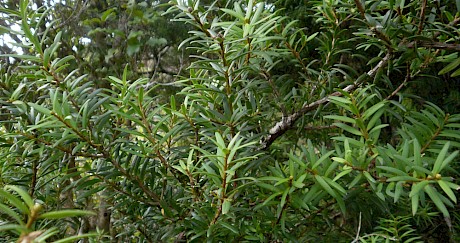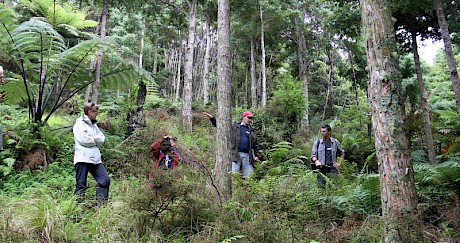Puriri (Vitex lucens)
History
Puriri was widely used by Maori in pre-European times. The wood made weapons and implements and the leaves a decoction used for bathing sprains, backache and ulcers or drunk for sore throats. One of the chemical constituents of the leaves is the methyl ester of p-hydroxybenzoic acid, which has been patented as a germicide. A member of the same genus as puriri, Vitex agnus-castus, was used medicinally by both the Greeks and Romans. Puriri timber has not been widely used by Europeans because the species is usually found as scattered, often poorly formed trees not suitable for milling. Its relative scarcity may be due to it normally growing best on high quality, often volcanic soils. These would have been among the first areas cleared for farming by both Maori and European. European uses are however quite variable, ranging from structural timbers such as piles, sleepers and bridges to decorative furniture and wood-turning. It is reputedly the best fence post timber in New Zealand.
Distribution
Vitex is a wide spread tropical and subtropical genus, mainly occurring from India, through the East Indies to New Zealand. The family, Verbenaceae, contains other important economic species including teak (Tectona grandis). Puriri is a coastal and lowland tree, found from the far north to about latitude 39° 30’ – Opunaki on the west coast and Mahia Peninsula on the east. It is common on volcanic and similar soils and more scattered elsewhere. Puriri is the only member of the genus Vitex in New Zealand.
Tree size and growth
Allan states that puriri grows to a height of 20 metres and a diameter of 1.5 metres. However some of the largest trees are much larger with several growing to diameters of over 2 metres and one in New Plymouth reaching a height of 29 metres. The largest recorded timber volume is found in another New Plymouth tree, which has a clean trunk height of 11 metres. Its volume is about 9 m³ . Data on the growth of planted puriri is available from several sites. Height growth on good sites ranges from 0.5 to 1.0 metres and is initially quite rapid, reaching 15 metres in about 30 years. Thereafter the rate slows – taking another 30 years to reach 20 metres. Diameter growth is more consistent, averaging close to 1 cm M.A.I, which means that a tree is capable of reaching 50 cm d.b.h in 50 years. Its form responds well to growing beneath a tall nurse crop and with good management it is anticipated that harvestable trees could be grown in as little as 40 years.
Timber
Surprisingly the strength and durability characteristics of puriri have never been fully determined. The timber density at 15% moisture content averages 1105 kg/ m³ (range 993 – 1217 m³). This makes it the densest New Zealand timber except for Southern Rata (1140 m³). It is also very durable; posts are still sound after 20 to 30 years. It is reported to be difficult to work because of its interlaced fibres.
Insect damage
Puriri’s greatest problem is that it is very prone to attack by the puriri moth (Aenetus virescens) which drills a “7” shaped tunnel, about 140 mm long and 18 mm diameter into the trunk. They appear to attack the trees up to about 30 cm d.b.h and severely damaged trees are unusable except for low grade structural work. The puriri moth also damages a wide range of other native and exotic species although beech and puriri appear to be the only native timber species attacked. As the puriri moth is not present in the South Island it may be possible to grow puriri on suitable sites there. Geoff Wightman of Kaikohe stated, at a Northland workshop in November 2002, that there may be several types of puriri, one of which appears to be resistant to puriri moth.
Potential
It has several characteristics which render it a very useful species. It is durable, dense and strong; thus having potential as a structural and below ground timber. It is an attractive wood with considerable potential for furniture and decorative purposes. Although frost tender as a seedling, it is one of the faster growing indigenous hardwoods. The drawback to its use is that which has inhibited its potential until now – attack by puriri moth.
Research requirements
The species needs a great deal more research. Fortunately Greg Steward of Forest Research is undertaking some work although more funding is needed to increase this activity. Of greatest importance, and requiring immediate attention, is to test the opinion that states some strains of puriri may be resistant to puriri moth or have other values. Analysis of the timber to determine its strength and durability characteristics is also needed.
References
- Allan H H 1961. Flora of New Zealand Vol. 1 Government Printer Wellington
- Alma P J 1977 Aenetus virescens (Doubleday) Puriri moth. Forest and timber insects in New Zealand No. 16. Forest Research Institute, Rotorua. 7p
- Brooker S G, Cambie R C & Cooper R C 1981. New Zealand Medicinal Plants. Heinmann
- Burstal S W & Sale E V 1984. Great Trees of New Zealand
- Clifton N C 1990. New Zealand timbers
- Cockayne L & Phillips Turner E 1939 The trees of New Zealand (3rd ed 1950). Government Printer, Wellington. 176 p
- Corkhill T 1948 A glossary of wood. Nema Press Ltd, London. 656p
- Howard A L 1948 The timbers of the world. MacMillan & Co, London
- Pardy G F, Bergin D O & Kimberley M O 1992. Survey of Native tree plantations. FRI Bulletin 175
- Steward G 1999 The potential for establishment and management of New Zealand native hardwood trees. In: Native trees for the future. Proceedings of a forum held at the University of Waikato 8 - 10 Oct. 1999. 22 - 27 Published by Centre for Continuing Education and Department of Biological Sciences. The University of Waikato
Species profile by Ian Barton


